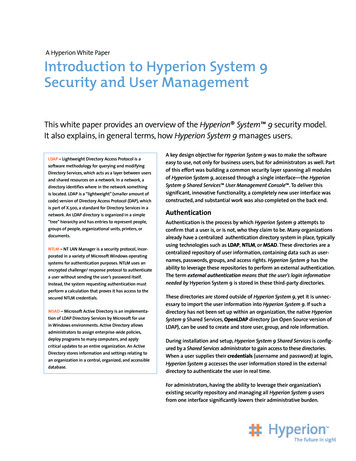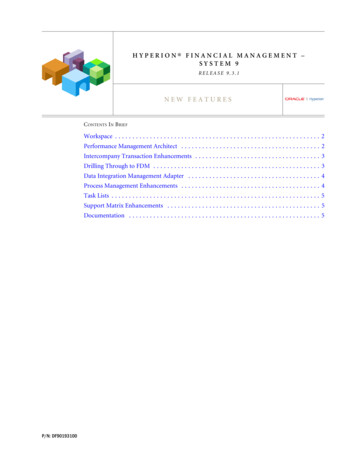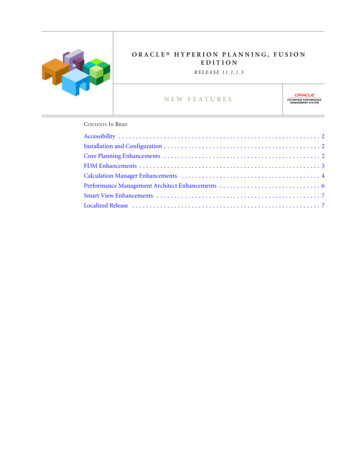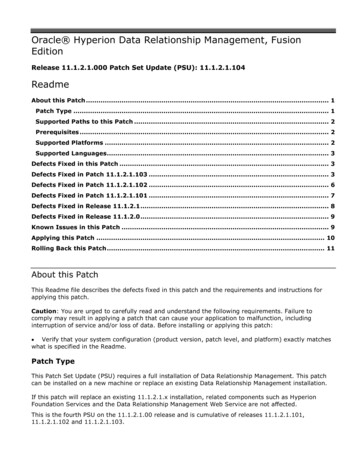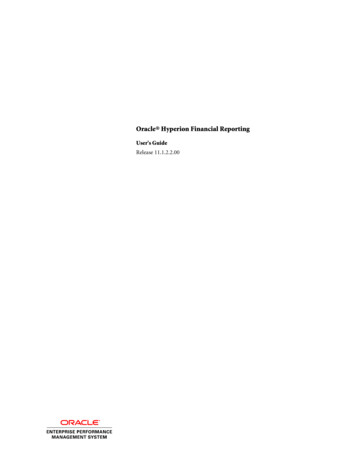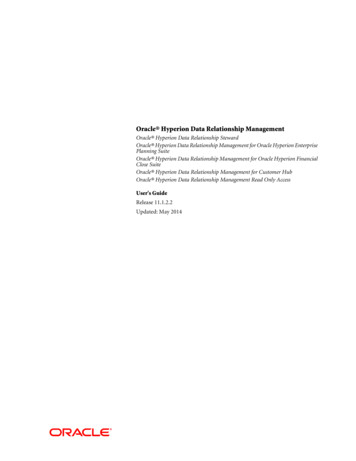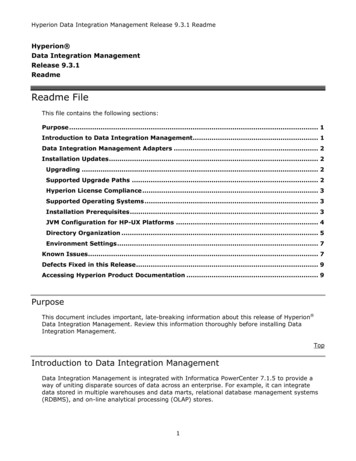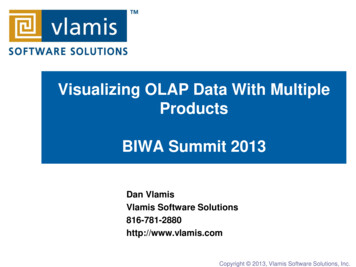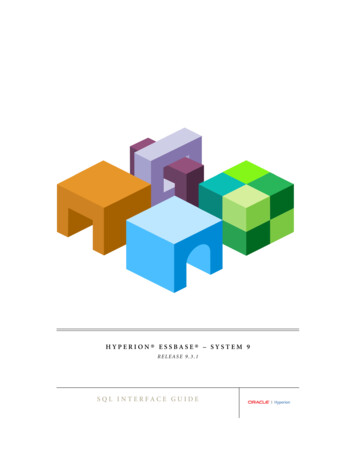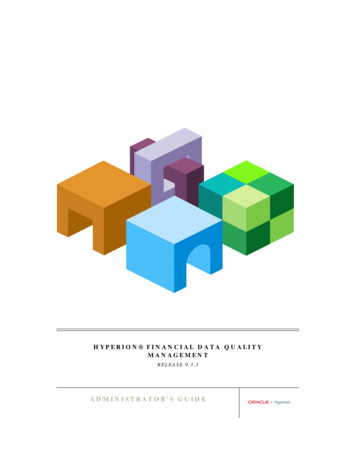
Transcription
HYPERION FINANCIAL DATA QUALITYMANAGEMENTRELEASE 9.3.1ADMINISTRATOR'S GUIDE
FDM Administrator's Guide, 9.3.1Copyright 1989, 2007, Oracle and/or its affiliates. All rights reserved.Authors: John BillingerThe Programs (which include both the software and documentation) contain proprietary information; they are providedunder a license agreement containing restrictions on use and disclosure and are also protected by copyright, patent, andother intellectual and industrial property laws. Reverse engineering, disassembly, or decompilation of the Programs, exceptto the extent required to obtain interoperability with other independently created software or as specified by law, isprohibited.The information contained in this document is subject to change without notice. If you find any problems in thedocumentation, please report them to us in writing. This document is not warranted to be error-free. Except as may beexpressly permitted in your license agreement for these Programs, no part of these Programs may be reproduced ortransmitted in any form or by any means, electronic or mechanical, for any purpose.If the Programs are delivered to the United States Government or anyone licensing or using the Programs on behalf of theUnited States Government, the following notice is applicable:U.S. GOVERNMENT RIGHTS Programs, software, databases, and related documentation and technical data delivered toU.S. Government customers are "commercial computer software" or "commercial technical data" pursuant to theapplicable Federal Acquisition Regulation and agency-specific supplemental regulations. As such, use, duplication,disclosure, modification, and adaptation of the Programs, including documentation and technical data, shall be subjectto the licensing restrictions set forth in the applicable Oracle license agreement, and, to the extent applicable, the additionalrights set forth in FAR 52.227-19, Commercial Computer Software--Restricted Rights (June 1987). Oracle USA, Inc., 500Oracle Parkway, Redwood City, CA 94065.The Programs are not intended for use in any nuclear, aviation, mass transit, medical, or other inherently dangerousapplications. It shall be the licensee's responsibility to take all appropriate fail-safe, backup, redundancy and other measuresto ensure the safe use of such applications if the Programs are used for such purposes, and we disclaim liability for anydamages caused by such use of the Programs.Oracle is a registered trademark of Oracle Corporation and/or its affiliates. Other names may be trademarks of theirrespective owners.The Programs may provide links to Web sites and access to content, products, and services from third parties. Oracle isnot responsible for the availability of, or any content provided on, third-party Web sites. You bear all risks associated withthe use of such content. If you choose to purchase any products or services from a third party, the relationship is directlybetween you and the third party. Oracle is not responsible for: (a) the quality of third-party products or services; or (b)fulfilling any of the terms of the agreement with the third party, including delivery of products or services and warrantyobligations related to purchased products or services. Oracle is not responsible for any loss or damage of any sort that youmay incur from dealing with any third party.
ContentsChapter 1. Basics of FDM . 13About FDM . 13Key Features and Benefits . 14Product Set . 15Definition of a FDM Application . 16FDM Application Architecture . 16Data . 17Inbox . 17Outbox . 18Reports Directory . 18Setting Up the Server Load Balance Group . 18Adapters . 19Adapter DLL/EXE . 19Adapter XML . 19Chapter 2. Managing Applications . 23Working with the Application Screen . 23Logging into an Application for the First Time . 27Chapter 3. Navigating FDM . 29Functions in Workbench . 29Command Buttons . 30Functions in Web Client . 30Desktop . 30Workflow Menu . 31Working with Data in Grids . 31Sorting Columns . 32Searching Control Trees . 33Customizing the Interface . 33Locking and Unlocking the POV . 36Locking and Unlocking the POV Mode . 37Functions Common to Web Client and Workbench . 37Contentsiii
Switching POV Mode . 37Setting Location POV . 38Setting Category POV . 38Setting Period POV . 38Searching the POV . 39Locking and Unlocking the System . 39How Users Default Points-of-View are Determined . 39Chapter 4. Configuring System Settings . 41System Options . 41Configuring Application Settings . 41Application Setting Options . 42Configuring Integration Settings . 43Setting Configuration Options . 45Chapter 5. Assigning FDM Security and Managing Users . 49Security . 49Assigning Application Object Security . 49Location Security . 50Managing Users . 50Adding Users . 51Setting User Application Rights . 51Setting User Location Rights . 52Deleting Users . 52Changing Target-System Passwords . 53Chapter 6. Dimensions . 55Activating Mappable Dimensions . 55Dimension . 55Alias . 55Calc Sequence . 55Enabled . 56Use As Lookup . 56Labeling Dimensions . 56Chapter 7. Working with Control Tables . 57About Control Tables . 57Setting Up Periods . 57Setting Up Periods Control Tables for Override Adapters . 59Data Maintenance Considerations . 59ivContents
Setting Up Categories . 59Setting Up Category Control Tables for Override Adapters . 61Data Maintenance Considerations . 61Setting up Currency Codes . 61Chapter 8. Working with Data Load Locations . 63About Data Load Locations . 63FDM Location Types . 63Creating FDM Locations . 64Creating Location Directories . 64Location Attributes . 64Organizational Changes . 66Chapter 9. Logic Accounts . 67Logic Accounts . 67Creating Logic Groups . 67Logic Type . 67Simple Logic Accounts . 67Creating Complex Logic Accounts . 73Chapter 10. Import Formats . 79Overview . 79Creating New Import Groups . 79Defining Fields for Import Groups . 80Defining Fields for Fixed Import Groups . 80Defining Fields for a Delimited Import Group . 80Drag and Drop Field Definition . 80Assigning Import Formats . 81Advanced Import Features . 82Adding Import Expressions and Import Scripts . 82Building Import Scripts . 87Building Integration Scripts . 88Using Adapter Import Groups . 89Expression Stacking and Processing Order . 90Chapter 11. Mapping Tables . 91Overview . 91Map Types . 91Explicit Mapping (one-to-one) . 92Wildcard Mapping . 93Contentsv
Conditional Mapping . 96Map Processing Order . 100Processing Order Across Multiple Mapping Types . 100Processing Order within the Same Mapping Type . 100Copying Mapping Tables . 101Restoring Maps . 101Recalculating Logic Accounts and Maps . 101Importing Mapping Tables . 102LedgerLink Conversion Tables . 102Hyperion Enterprise Conversion Tables . 103Account Conversion Table Format/FDM Equivalent . 103LedgerLink TRA / FDM Equivalent . 103LedgerLink TRN / FDM Equivalent . 103Importing Descriptions in LedgerLink format . 104Hyperion Enterprise Conversion Tables . 104Account Conversion Table Format/FDM Equivalent . 104Importing Excel maps . 104Chapter 12. Financial Controls . 105Creating Control Groups . 105Sections . 106Questions . 107Recycle Bin . 110Question Profiles . 111Process Explorer . 113Adding Memos and Attaching Documentation . 113Certification Process . 114Chapter 13. Validation Rules and Entities . 115Creating a Validation Rule Group . 116Creating Validation Rules . 116Display Value . 117Description . 118Rule Name . 119Rule Text . 119Type . 119Category . 119Sequence . 120Rule Logic . 120Validation Editor . 124viContents
Validation Entity Groups . 127Defining Validation Entities . 127Chapter 14. Process Flow . 129Importing Source Data . 129Load Method (Import Type) . 129Import Process Stream . 129Viewing Conversion Rules (Drill-up) . 130Data Archiving . 130Attaching Memos to Detail Lines . 131Attribute Drill Up . 132Validating Source Data . 132Validation Form No Mapping Errors . 132Validation Form Mapping Errors . 133Exporting to Target System . 134Drill-Down Analysis . 134Attaching Memos and Source Data Retrieval . 134Drill-Back from Financial Management . 134Consolidating Target System . 136Consolidation Parameters . 136Consolidation Errors . 136Validating Target System Data (Check) . 136Chapter 15. Importing Other Data Files . 137Journals . 137Defining a Journal Template . 137Journal Data Validation . 141Processing a Journal Template . 141Journal Security . 142Excel-Based Trial Balance Files . 142Overview . 142Text File Trial Balance Load vs. Excel Trial Balance Load . 142Defining an Excel-Based Trial Balance Template . 142Multiload Files . 143Text File Multiload vs. Excel Multiload . 143Defining Multiload Templates . 143Multiload Excel Template Data Validation . 150Multiload Action Events . 151Checking In a Multiload File . 151Importing a Multiload File . 152Contentsvii
Validating a Multiload File . 152Loading a Multiload File . 152Consolidating a Multiload File . 153Running Validation Reports for a Multiload File . 153Multiload Security . 153Multiload Data Fields . 153Chapter 16. Reports . 155Running Reports . 155Report Viewer . 155Maintaining Reports . 156Changing Descriptions . 156Process Monitor Reports . 156Designing a Report . 156Setting Report Group Security . 156Chapter 17. Batch Loader . 159Overview . 159Preparing Batch Loader Files . 159File Name Format . 159Batch File Location . 160Multiload File Name Format . 160Multiload File Batch Directory . 160Running Batch Loader . 160Batch Controls .
Oracle's Hyperion Financial Data Quality Management (FDM) is an out-of-the-box data transformation tool that feeds source-level financial data to consolidation, reporting, planning, and analytical applications.

